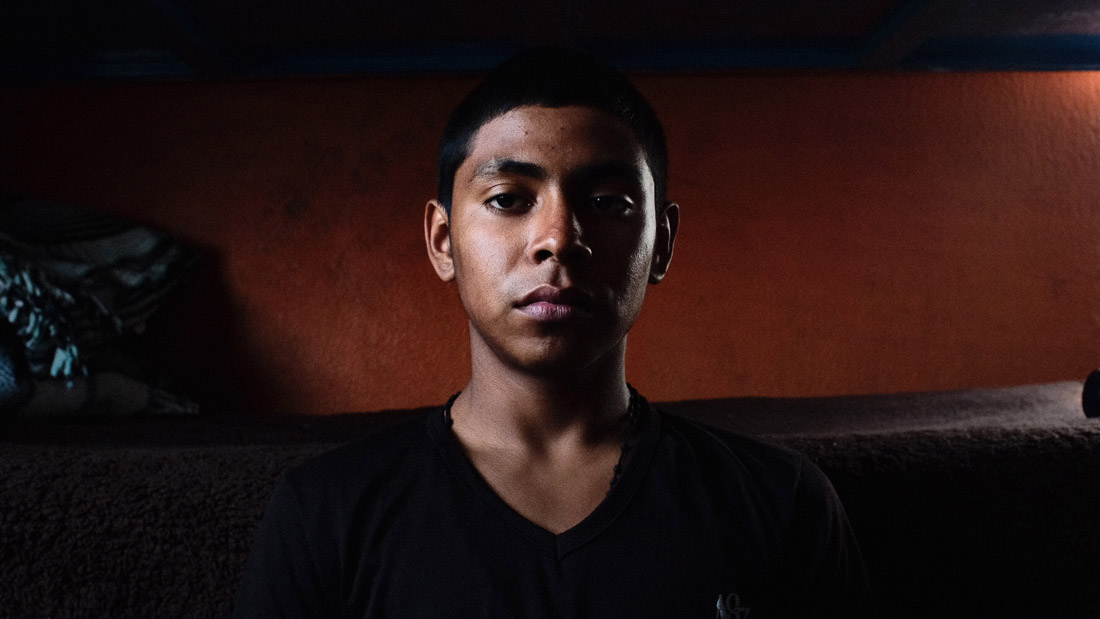As Carlos Morales’ short documentary Sinfonía de un mar triste (Symphony of a sad sea) opens, we see its young protagonist Hugo staring longingly at the vastness of the ocean. He does push-ups and sit-ups in his makeshift bedroom. These are intimate shots of a Mexican teenager’s seemingly ordinary life – but they belie the powerful story he’s about to tell.
For close to 12 minutes, while the film’s images document the mundanity of his day-to-day, Hugo narrates a harrowing story of family violence and loss; including the murder of his teenaged brother, and how his father was forced to flee the violence at home by emigrating to the U.S. The result is that there’s no way to disentangle Hugo’s daily life from the horrors that have shaped it. For now, he has only one goal: to cross the border and join his father. Wall or no wall.
Symphony of a Sad Sea, which already screened at the Morelia Film Festival, was selected as part of the 2018 Sundance Film Festival lineup. Morales takes joy in knowing that the short is headed to the very country his protagonist Hugo had dreamed of crossing into, and hopes it helps change people’s minds about how we talk about immigration in the United States.
Ahead of the doc’s premiere in Park City, Remezcla caught up with the director to talk about why immigration has become so central to his work, why he opted to dispense with the kind of contextual talking heads documentaries usually use, and why stories like Hugo’s deserve to be told. Check out our conversation below.
Symphony of a Sad Sea screens as part of the Documentary Shorts Program 1 at the Sundance Film Festival
How did you get started in filmmaking?
I’ve always loved telling stories. When I was a little kid my dad and I used to make our own radio novelas; we’d record them on cassette tapes and only ever listen to them if we got too bored. I studied engineering in Chiapas, which is where I’m from, [but] once I tried to make a career out of it, I realized I didn’t want to do that with my life. That’s when I was forced to find an alternative, and how I got started in the audiovisual world. For a while I did some TV work and then I did some research for Carolina Rivas’ immigration-themed documentary Lecciones para Zafirah. It’s a harrowing doc that shows just how painful the journey through Mexico can be for Central Americans cutting through. The issue of immigration calls out to me, maybe because I sometimes feel like a migrant in my own country. While working on that movie I was taking filmmaking classes and then in 2012 I decided to begin work on a documentary (which I’ve yet to finish) that talks about these same issues but from the point of view of those who have been deported.
What draws you to the documentary genre?
I have more experience as a viewer than as a maker of documentaries, but I can tell you that the genre has the power to seduce not just your senses but the souls of those who watch them. I really enjoy Mexican documentaries because, given their distance from commercial filmmaking, they’re left to their own devices. There’s such originality and creativity there. Just look at the recent work of Tatiana Huezo or Everardo Gonzalez. And then, as a filmmaker, I’m attracted to the documentary form because it’s an excuse to get close to real life stories that I wouldn’t otherwise be exposed to.
How did you meet Hugo?
I knew I wanted to tell a story about immigration, but this time from the point of view of a child. I started doing some research, knowing the risks minors who migrate from Central America to the United States face as they cross through Mexico. [But] following a migrant on this journey would come with its own set of complications in terms of production and budget. So my producer Claudia Vicke and I opted to find a story in the northern border. I took various trips to the U.S. border, and during one of those trips I visited a YMCA house for young migrants. That’s where I met Hugo. His story changed the idea I had for the documentary. It struck me to get to know someone so intimately who’d been a victim of the violence that afflicts my country. I wanted to show his story in the same way that I first heard it. When I listened to him I didn’t need to know more [context], perhaps because I’m very used to hearing about these kinds of violent stories.
For years now the violence in Mexico has been all but normalized. Many of us here know the reasons behind this absurd war against drug trafficking that the government continues to wage. That’s why I thought Hugo’s tale by itself would be enough. You can feel the context—you know it well enough that you can fill in the blanks. The hardest part was in the editing room. Sorting through what Hugo had given us was very difficult. I kept being overwhelmed by the fact that someone so young could have lived through such misfortune.

Why is it crucial to tell these stories in 2018?
I think it’s important to tell these stories because they become faithful witnesses to our times. In many cases, like in Hugo’s case, there is no claim to justice. Putting his story on screen, recording his testimony eases a bit the indifference with which he’s been treated by those in power. The documentary translates statistics and faceless numbers of those affected by violence into stories that require reflection. What I hope this film does is give a voice to Hugo, who himself represents so many men, women and children who have had to flee or suffer the loss of a loved one at the hand of the violence that runs through so much of Mexico. Symphony of a Sad Sea is but a small tale of the immense injustice that runs rampant here.
Are you still in contact with Hugo? What does he think about the film?
Hugo is now in the United States, living in a hostel. His immigration status is looking good. He’s just waiting to come of age so that he won’t need to depend on anyone to be able to stay in the country and thus not risk his father getting deported. Because of security issues, we’ve not been able to get in contact with him. We know what he’s up to because of the coordinator at the YMCA house. I’m sure he’ll enjoy the film once he gets a chance to see it. All of us who worked on the film are eager to talk to him again like we did until just a few months ago.
This interview was conducted in Spanish and translated for Remezcla by the author.







